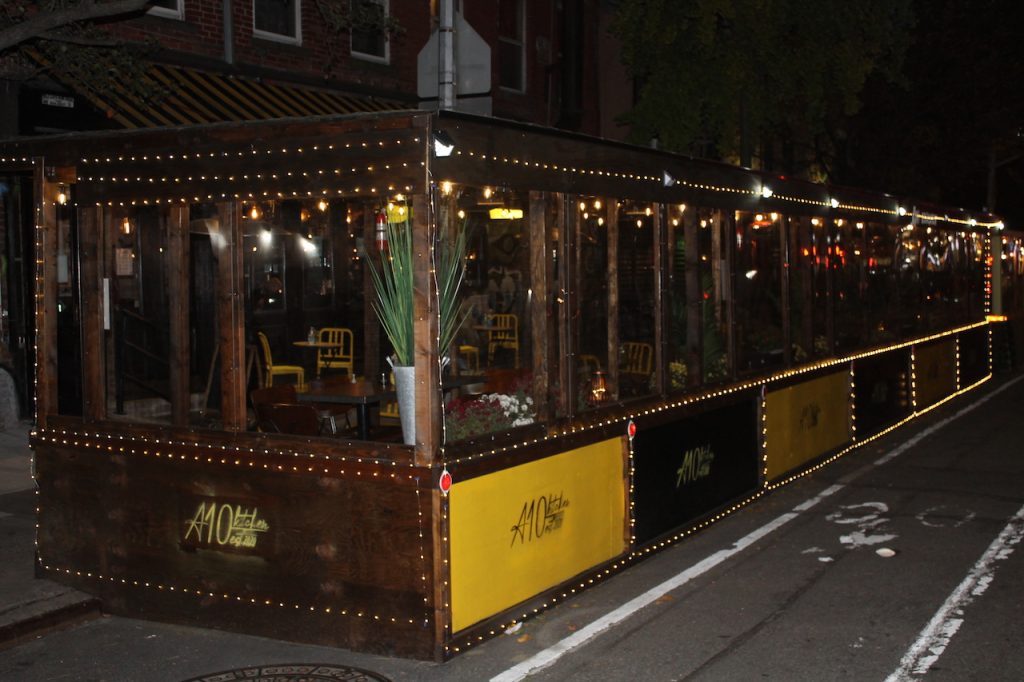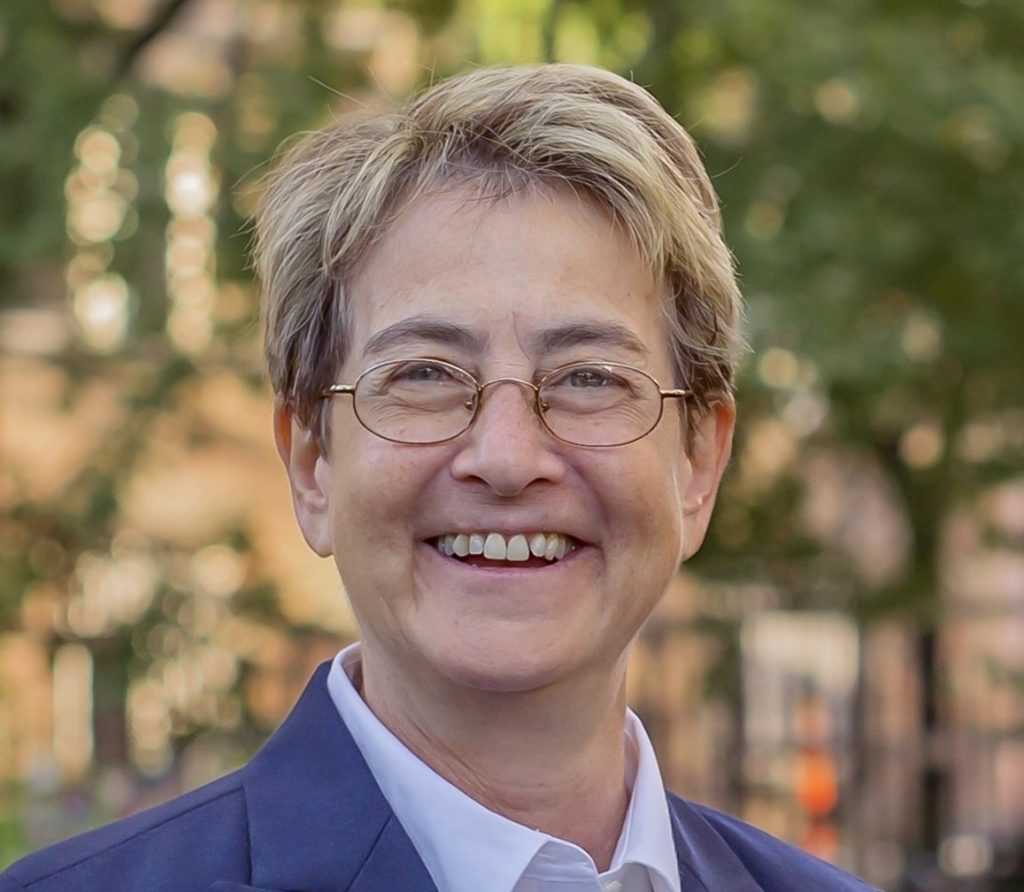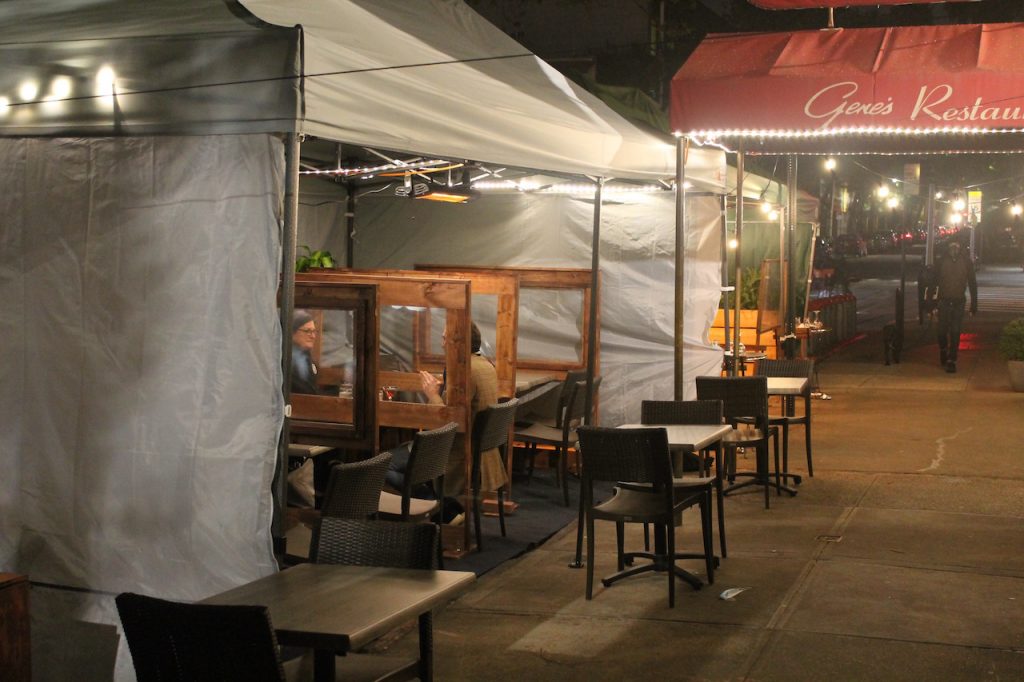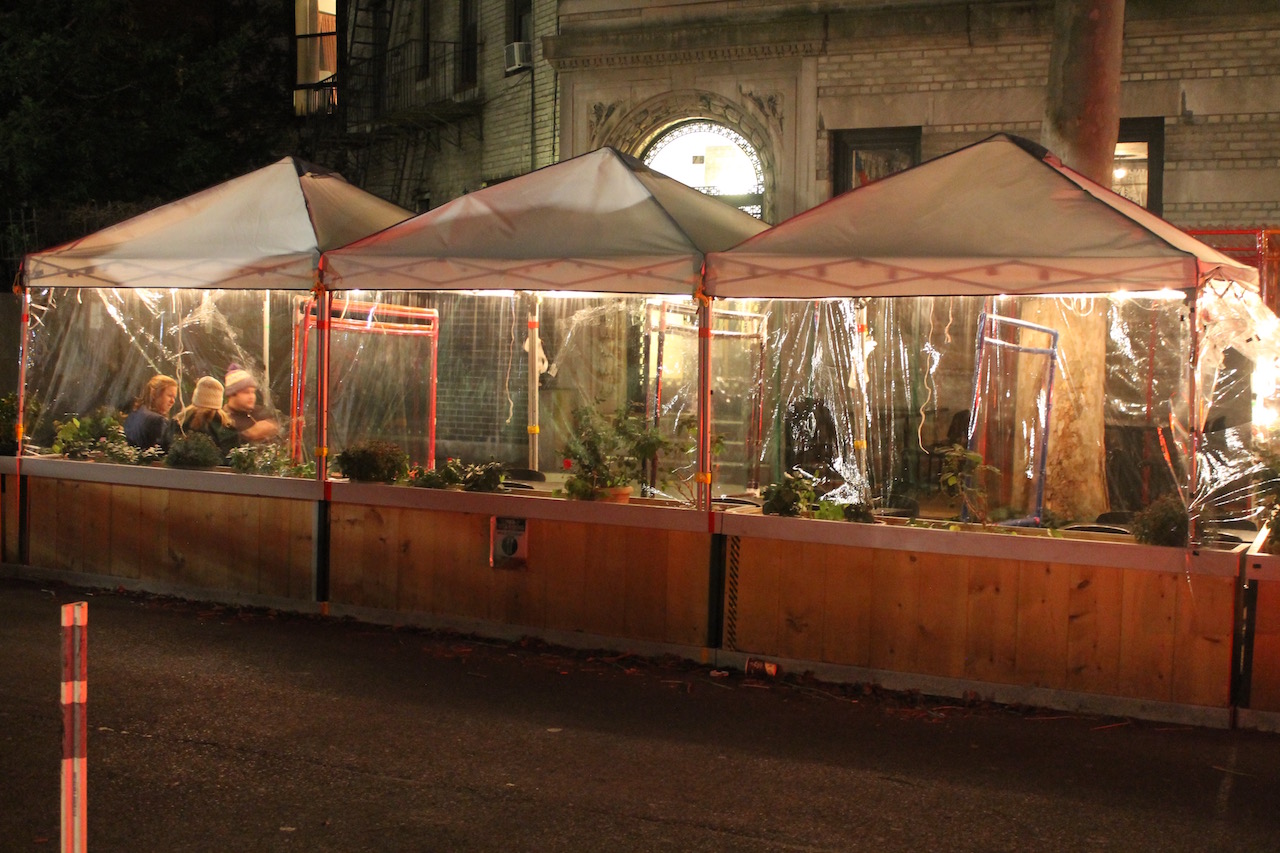BY THE VILLAGE SUN | The mayor and City Council making the Open Restaurants program permanent without any community review has left a bad taste for Deborah Glick.
On Oct. 30, the assemblymember wrote Mayor de Blasio, Council Speaker Corey Johnson and Polly Trottenberg, the commissioner of the Department of Transportation, to voice her disapproval. D.O.T. is the agency overseeing the pandemic-inspired program.
On top of the lack of public review, the letter cited a smorgasbord of concerns, from the “ceding of public space to private industry” to the danger of propane heaters and streets being made impassable due to outdoor dining structures.
Last month the City Council O.K.’d the program for another year, intending to make it permanent after that.

“While I have supported many emergency measures, including the Open
Streets and Open Restaurants initiative, I am seriously concerned about the way in which unilateral policy decisions are being made without sufficient input from the public,” Glick wrote. “Originally, the outdoor dining program appeared to be acceptable as long as it was temporary and only permissible on an emergency basis. However, it is inappropriate for the City Council to make this policy permanent without adequate public review or debate.”
Glick slammed decreeing the Open Restaurants program permanent as “ceding” public space to the private sector without the usual public vetting.
“Without sufficient review at the community board level or with city agencies,” she wrote, “the City Council would effectively be ceding an incredible amount of public space to private industry. Restaurants serve a purpose and employ thousands of New Yorkers. However, in this instance, the City Council has chosen to ignore potential legal requirements and norms in City government when public spaces are being used for private enterprise. This large-scale, citywide change has occurred without the need for any Uniform Land Use Review Procedure or an Environmental Impact Statement.”

Glick warned that the move could result in business improvement districts gaining even more control over the streetscape than they currently exert.
“New York City has active Business Improvement Districts (BIDs) which already monopolize public space and, at times, make ethically tenuous connections between the public’s money and private business,” she wrote. “I am concerned that the BIDs will have ultimate authority in plazas and squares throughout the city to allocate space for outdoor dining in the future. Because many restaurants are members of BIDs, this would not serve the interest of the local community and may be a conflict of interest.”

Glick further expressed concern about propane and electric heaters being used for the outdoor dining spaces in the cold weather, calling it a potentially disastrous situation.
“The City must prioritize safety as these heaters have open flames and may be under tree canopies or next to the wooden roadway seating,” she warned.
Under rules for outdoor dining recently crafted by the Fire Department, propane heaters can be used on the sidewalk but not in the street.
Glick added that there must be assurances that roadway seating not block ambulances, fire engines, sanitation trucks and snowplows, noting that parts of her district, like Greenwich Village, have narrow streets. Plus, vehicles need curbside access, she stressed.
“Sidewalk accessibility must be considered in this program,” she said, “as many differently abled individuals require Access-a-Ride or cabs with lifts in order to get around the City.”
The politician concluded her letter by assuring that she supports the restaurant industry and would like to see residents continue to enjoy outdoor dining.
“Nonetheless,” she said, “this program should not have been made permanent without public review even in the face of public fear.”


No public input whatsoever is an unacceptable way to transform our cityscape. If an argument is to be made that our streets are for all, not just parking spots, then why do they get ceded to mostly all liquor-serving establishments (as bars are now eating establishments, don’t ya know)? Seems a bit slanted toward one industry. And what about the small businesses that don’t have commercial vehicles and use their noncommercial vehicles to do business? It has been impossible to navigate delivering, picking up and, yes, parking for these small business. It is simply an unfair giveaway to a single industry, while the rest of the city, businesses and residents make serious sacrifices for these new pieces of real estate (and income) their restaurant neighbors now enjoy. To those who say, “It’s New York…if you don’t love street life then….”, I say, yes we are New York, not New Orleans. All of these seemingly small issues (often involving how one operates using a NYS Liquor Authority license) shape the tenor of our city life. And, NO, even though I love New Orleans, I prefer New York and enjoy and need the quality of life protections versus the tack that we’ve taken toward street-side partying. Thanks, Deborah Glick, and shame on de Blasio and my City Council rep Carlina Rivera, who seem gravely out of touch with their constituents.
And PS. I believe that residents should accept and support these outdoor dining measures during covid on a temporary basis. And my block is fully supportive of our restaurants and whatever they must do to survive this pandemic.
Thank you, Deborah Glick! We all want restaurants to survive, but the permanent-looking wooden buildings with glass double-hung windows out on the street are absurd. How is this safer than eating indoors? Just take a walk around Sixth Avenue, Greenwich Avenue, Carmine Street, etc. Also, in some places roofs are being built from the building to the curb so that pedestrians have no choice but to walk right through the middle of this outdoor “restaurant.” It’s basically the Wild West out there and it’s shocking (yet sadly not surprising) that the dysfunctional City Council thinks this should be made permanent, especially without appropriate hearings, regulations and fees to compensate the taxpayers for lost parking revenue and increased costs. Sidewalk cafes are nice but there are only a few places in the Village that have wide enough sidewalks to accommodate them. When the pandemic is over, that should be the extent of outdoor dining.
I agree with Deborah Glick: “Originally, the outdoor dining program appeared to be acceptable as long as it was temporary and only permissible on an emergency basis. However, it is inappropriate for the City Council to make this policy permanent without adequate public review or debate.” We, in our communities, should have a say in this decision. There are numerous problems with these outdoor dining structures. Some are fully enclosed threatening to be super spreaders. Also, the noisy crowds on the street threaten quality of life in our neighborhoods, not to mention the propane heaters, which are a fire hazard since many of the buildings are defined as combustible.
Streets should be for cars and trucks. People should eat inside or at home – full stop. Lets stop with this nonsense.
Thank you, Deborah Glick, for your thoughtful and reasonable response to what is essentially a land grab for the all too powerful real estate industry.
Milling/roadwork just recently took place in my neighborhood. It was absurd and even comical to witness how the NYC DOT failed to require outdoor restaurant seating areas to be removed, so that the DOT could actually get the job done correctly. The result has not only left our neighborhood with a visual eyesore, the thoroughly inadequate job is a waste of taxpayer dollars. Is this the Mayor’s idea of how best to repair NYC’s “infrastructure”?
I also fear for the many residents living on the streets in my neighborhood of Little Italy and surrounding areas, where outdoor dining “facilities” have become permanent little “houses.” G-d forbid a fire should break out on one of these very narrow streets, it is terrifyingly easy to imagine that breaking down the permanently built little “houses,” in order to provide adequate access to emergency vehicles, would most certainly cause a serious delay and potentially deadly outcome.
Just think: UNENFORCED self-certified propane heater storage in a non-fireproof, tenement house residential building built in — let’s say — 1901.
Please, Mayor de Blasio and the members of our City Council, just consider that one size does NOT fit all.
Why do you live in a big city if you hate the vibrancy of street life so much? Open Restaurants and outdoor dining includes various regulations that allow for emergency access including on the so-called “very narrow streets.” It’s tough for me to understand why you hate something that is keeping a vital NYC industry afloat and has made the city streets more vibrant and alive than they are when lined with inert parked cars.
Why are you jumping straight to “you hate the vibrancy of street life,” VLM? Marna’s concerns about fire, emergency access and infrastructure repair are perfectly legit.
Cars have to be moved twice a week. These street shanties are parked in perpetuity. By what right?
There is little difference between free car storage and free restaurant use, isn’t there? Both are private uses. As a matter of fact, so are bicycle corrals. Everything here is a balance, and right now, the balance is out of whack because restaurants are given priority with no neighborhood input.
My comment above was addressed to Choresh Wald, but inadvertently was placed under Marna Lawrence’s appropriate comment, with which I agree entirely.
Aside from the serious political and social issues raised in this article, many restaurants, in their efforts to afford outside dining, are replicating the features of their interior spaces, including enclosures with limited ventilation, which undermines the purpose of allowing such outdoor dining. Some of them, in fact, are miniature versions of their indoor restaurants. I hope that government standards and inspections will address these shortcomings.
“Ceding” public space to the private sector? The public space is not available for the public to use it. It is only available to 20% of area residents who are car owners. Nobody else can use it otherwise. Not only that, the city allows the usage of a public space for the storage of private property (personal cars) for free, which doesn’t make any sense.
Roadway seating areas do not block ambulances, they are the same width a parked car takes, so that’s nonsense.
And yes, people need curb access, Access-a-Ride customers, taxi riders, Uber dropoff and pick-up, delivery vehicles, utility vehicles: all these street users have no curb access when designated Alternate Side Parking. Free parking needs to be abolished and multiple loading zones need to be designated on every block. I hope this is on your agenda Erik Botcher and Arthur Schwartz.
Choresh Wald, Deborah Glick’s voter and constituent
Choresh. Sounds like you yearn for the good old days when horses fouled the streets and knee-high boots were a necessity. Imagine having to bike through that!
Your continuing rants about cars and their allegedly only super-rich owners are tiresome; let alone inaccurate and misleading.
The streets serve many competing uses and always will. Get used to it.
Nope. Not horse and buggies. I am advocating for free curb access for Emergency, Utility, Delivery, Access-a-Ride vehicles, drop-off and pickups by For Hire Vehicles, Taxis, School Buses. For all these street users to operate efficiently, the city needs to abolish Free Car Storage (aka Alternate Side Parking). That’s all, a very simple solution that will benefit a vast majority of area residents.
Oh, please. I’ll bet less than 20% of area residents have small children, do you begrudge them playgrounds?
Roadways are public conveyances, parking spots are part of that. Take your tired old TransAlt talking points elsewhere.